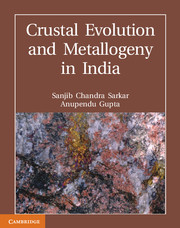Book contents
- Frontmatter
- Dedication
- Contents
- List of Figures
- List of Tables
- List of Plates
- Preface
- Chapter 1 Southern India
- Chapter 2 Central India
- Chapter 3 Eastern Ghat Belt
- Chapter 4 Eastern India
- Chapter 5 North-East India
- Chapter 6 Western India
- Chapter 7 The Himalaya
- Chapter 8 Crustal Evolution and Metallogeny in India: A Brief Review in the Context of the World Scenario
- References
- Index
- Plate Section
Chapter 7 - The Himalaya
Published online by Cambridge University Press: 05 February 2014
- Frontmatter
- Dedication
- Contents
- List of Figures
- List of Tables
- List of Plates
- Preface
- Chapter 1 Southern India
- Chapter 2 Central India
- Chapter 3 Eastern Ghat Belt
- Chapter 4 Eastern India
- Chapter 5 North-East India
- Chapter 6 Western India
- Chapter 7 The Himalaya
- Chapter 8 Crustal Evolution and Metallogeny in India: A Brief Review in the Context of the World Scenario
- References
- Index
- Plate Section
Summary
Geology and Crustal Evolution
Introduction
‘Hima’ in Sanskrit – an old Indo-Aryan language–is chill/snow and ‘Alaya’ in the same is home. So Himalaya is the ‘home to snow’. It is needless to say that the life and culture of the people of South Asia are beholden to the Himalaya in more than one way. It saves people of the Indian subcontinent from the freezing cold winds coming from the north during the winter. It, on the other hand, particularly in its eastern part, faces the monsoon coming from the Bay of Bengal during June–August; and is a major cause of heavy rains in the Ganga (Ganges)–Brahmaputra valleys. The Indus–Ganga–Brahmaputra river-system, originating from the Himalaya, is the lifeline of a majority of population in the corresponding valleys. To the Hindus, the Himalaya has been the abode of gods. Not infrequently, there have been major earth-shakes or earthquakes in the Himalaya causing huge damage to life and property, particularly in the region close to its southern border. The simple folk living there have accepted such disasters as divine retribution. The attitude is, however, changing.
Geological investigation of the Himalaya started with the setting up of the Geological Survey of India in 1851. Since then the scientists of the Geological Survey of India, other government agencies, academia and research institutes (for example, the Wadia Institute of Himalayan Geology at Dehradun) are continuing their investigations into the geology of this mountain belt.
- Type
- Chapter
- Information
- Crustal Evolution and Metallogeny in India , pp. 679 - 716Publisher: Cambridge University PressPrint publication year: 2012



